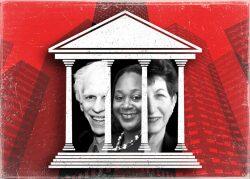In New York politics, even the simplest solutions prove to be difficult.
Land use attorney Ken Fisher flagged on LinkedIn a New York Focus story about a plan to ease judicial backlogs in the city, which are a problem for the real estate industry. What worried him is that some important people actually oppose the plan.
To Fisher, a former City Council member, the issue is clear.
“Judges are responsible for unmanageable caseloads. I have waited a year for a motion decision and three years or more for an appellate decision,” he wrote.
One of his most frustrating delays was in the Elizabeth Street Garden case, when developer Pennrose had to wait years for a ruling so it could build affordable housing for seniors.
By the time the opponents were finally defeated, Mayor Eric Adams had lost his enthusiasm for the project. After a decade of planning and litigation, the whole thing is in jeopardy.
Among the reasons for the judicial backlog is that the state constitution allows no more than one Supreme Court justice per 50,000 residents in each of the state’s 13 judicial districts.
That’s not a problem in much of the state, but it is in Manhattan, the Bronx and Albany — especially for real estate, which is among the most litigious industries.
“Seems to me,” Fisher wrote, “the opposition doesn’t take into account that, unsurprisingly, far more cases per resident are filed in Manhattan than in other counties.”
Reporter Chris Bragg’s article says the New York provision is based on language adopted in 1846 and last modified in 1963. Caseloads are three times greater than they were 60 years ago, according to Assembly member Alex Bores, who along with Sen. Brad Hoylman-Sigal is pushing the reform.
“The dumbest reason why we are so backlogged is that we don’t have enough judges,” Bores told Bragg. “There is no similar limit in the federal constitution. There is no similar limit in 49 states.”
There’s also a pretty dumb reason for opposition to the proposed amendment: Judges in conservative parts of the state don’t want the Democrat-dominated legislature to be able to put more judges per capita downstate. They say judicial districts west of Albany would suffer because resources could be pulled away from them.
I have a hard time wrapping my brain around how that would happen, but it’s telling that Manhattan Supreme Court justices support the amendment. Apparently, they don’t like having more than 2,000 cases on each of their dockets and several hundred motions awaiting rulings at any given time.
While upstate judges make amorphous arguments about how the legislature might distribute resources — each Supreme Court judgeship costs about $1 million annually — it’s obvious that resources should be distributed according to caseload, not population.
By that standard, under the current system, upstate is receiving far more judicial resources than Manhattan. Surely the upstate judges can see the hypocrisy in their own argument.
I have written that the highly politicized process to become a Supreme Court judge in New York also needs reform. But fixing it is complicated. Picking the low-hanging fruit first, as Hoylman-Sigal and Bores are trying to do, makes sense.
But even that turns out to be hard.
Read more

When big-time projects are stopped by small-time judges

Judge orders Nir Meir back to Rikers

Justice delayed: The endless frustration of housing court















































